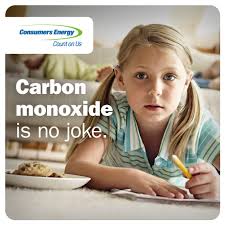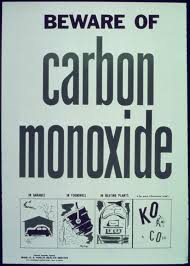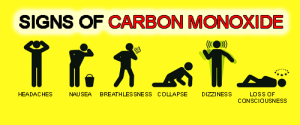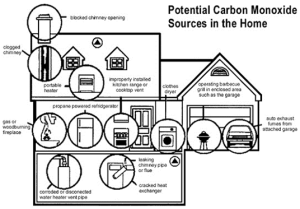The following article has some great advice about carbon monoxide and some facts everyone should know. This is aimed at student but I think it is an article everyone can benefit from. You can learn more about carbon monoxide from our about.me page.
What is Carbon Monoxide and how dangerous is it? As part of The National Student’s Advice Week, npower brings you the facts.
What is Carbon Monoxide – and what are its dangers?
1. Carbon Monoxide (CO) is a gas – it can be very dangerous to your health and can be fatal. It is sometimes referred to as the silent killer because it has no smell, taste or colour, which makes it difficult to detect.
2. CO is produced when fuels such as gas, oil, coal or wood do not burn fully.
3. When you breath in CO, it enters your bloodstream and mixes with haemoglobin (the part of red blood cells that carry oxygen around the body), to form carboxyhaemoglobin. This stops your blood from being able to carry oxygen which causes the body’s cells and tissue to die.
4.Every year in the UK around 200 people are admitted to hospital with suspected CO poisoning, leading to around 40 deaths.
5. Around 10-15% of people who suffer from severe or life-threatening CO poisoning develop long-term complications, such as damage to the brain or the heart.
How do you know if you’re suffering from Carbon Monoxide poisoning?
6. Initial symptoms of CO poisoning can be similar to flu, but without a fever and sometimes, can be confused with food poisoning.
7. The most common symptoms include: dizziness, headaches, nausea and vomiting, tiredness and confusion, stomach pain, shortness of breath and difficulty breathing.
What causes Carbon Monoxide to leak?
8. The most common causes are incorrectly installed, poorly maintained or poorly ventilated household appliances like fires (if the chimney or flue is blocked), cookers, heaters and central heating boilers.
Who is most at risk?
9. ‘High risk’ groups include the elderly, children, pregnant women and people with respiratory problems or chronic heart disease.
10. It is now a legal requirement for private landlords to fit a CO alarm in rooms used as living accommodation which also contain an appliance that burns, or is capable of burning solid fuel. Although there is no requirement to fit one near a gas boiler, it is still advisable as best practice.
How can you protect yourself from Carbon Monoxide poisoning in the home?
11. Install a Carbon Monoxide alarm near appliances that are capable of producing CO.
12. Look out for other tell-tale signs like:
13. Black, sooty marks on the front covers of gas fires, or sooty marks on the walls near boilers, stoves or fires
14. Smoke building up in rooms because of a faulty flue or blocked chimney
15. Gas appliances producing yellow flames instead of blue ones
16. Ensure all appliances are installed and regularly serviced by registered engineers.
17. If you have a chimney, make sure it is swept regularly by a qualified sweep.
Read more at the original article here.
These are all great facts about carbon monoxide and contain some great tips that we should all be on the look out for. The obvious thing to do is install a carbon monoxide alarm and make sure our fuel burning appliances are properly serviced yearly by a professional.
Of course, even without a carbon monoxide detector, some people can get lucky by speaking to the right person, see below.
NHS call handler saved my life after I was poisoned by carbon monoxide
An actress has told how how a quick-thinking NHS call handler saved her life after alerting emergency services to a carbon monoxide leak in her home.Jaynie Powsney, 29, called the NHS 111 line after experiencing dizzy spells, headaches, diarrhoea and a stomach ache for around a month.
And after suspecting her symptoms were due to the poisonous gas, dubbed the ‘silent killer’, the call handler dispatched an ambulance, fire crews, the National Grid and environmental protection to her home off Argyle Street, Heywood .
Jaynie said: “A fire engine arrived and we were told there were three more on the way.
“It was frightening. I felt silly at the time because I thought it was a tummy bug.
“The paramedics were certain it was carbon monoxide poisoning.
“They wanted to take me to hospital, but because we’d had the windows open some of the carbon monoxide in my system had passed.
Further reading where first published.
This person had a very lucky escape and luckily the call handler recognised some of the symptoms of carbon monoxide poisoning but some people do not get so lucky. Further news stories at this carbon monoxide news feed.











